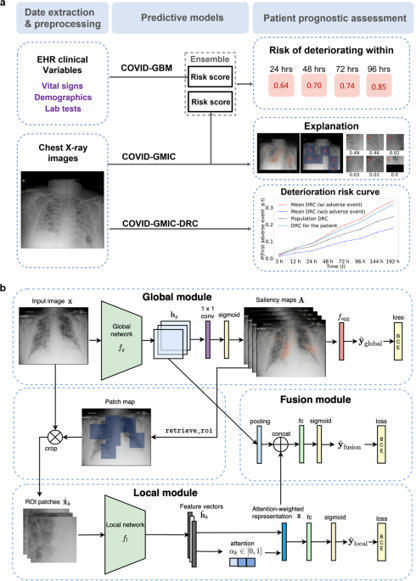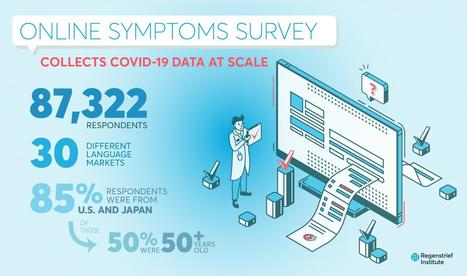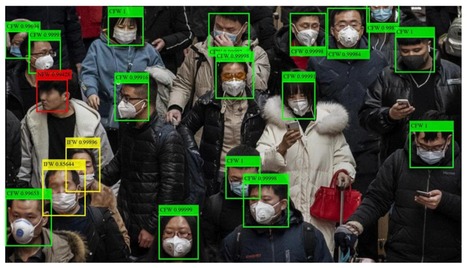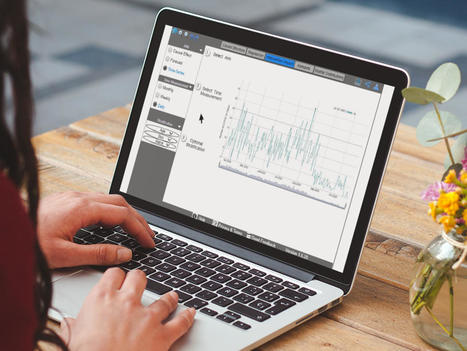 Your new post is loading...
 Your new post is loading...
This phylogenetic tree represents the clade distribution of global SARS-CoV-2 viral genomes since the beginning of the pandemic. In the center is the reference Wuhan-1 strain, with outside samples now separated by nucleotide divergence. The last few months have led to an explosion of new variants with further mutations in the viral spike resulting in further antibody evasion, and also carrying changes in many other viral proteins. Some recently sequenced viral genomes from samples collected in Southeast Asia (not shown in this figure) display over a hundred nucleotides changes when compared to Wuhan-1. The graph was generated with nextstrain.org Lire l'article complet sur : www.linkedin.com
Via Juan Lama, Dr. Stefan Gruenwald
During the coronavirus disease 2019 (COVID-19) pandemic, rapid and accurate triage of patients at the emergency department is critical to inform decision-making.
We propose a data-driven approach for automatic prediction of deterioration risk using a deep neural network that learns from chest X-ray images and a gradient boosting model that learns from routine clinical variables.
Our AI prognosis system, trained using data from 3661 patients, achieves an area under the receiver operating characteristic curve (AUC) of 0.786 (95% CI: 0.745–0.830) when predicting deterioration within 96 hours.
The deep neural network extracts informative areas of chest X-ray images to assist clinicians in interpreting the predictions and performs comparably to two radiologists in a reader study. In order to verify performance in a real clinical setting, we silently deployed a preliminary version of the deep neural network at New York University Langone Health during the first wave of the pandemic, which produced accurate predictions in real-time.
In summary, our findings demonstrate the potential of the proposed system for assisting front-line physicians in the triage of COVID-19 patients.
read the open article at https://www.nature.com/articles/s41746-021-00453-0
Lire l'article complet sur : www.nature.com
Via nrip
We discuss the concept of a participatory digital contact notification approach to assist tracing of contacts who are exposed to confirmed cases of coronavirus disease (COVID-19);
The core functionality of our concept is to provide a usable, labor-saving tool for contact tracing by confirmed cases themselves
the approach is simple and affordable for countries with limited access to health care resources and advanced technology.
The proposed tool serves as a supplemental contract tracing approach to counteract the shortage of health care staff while providing privacy protection for both cases and contacts.
- This tool can be deployed on the internet or as a plugin for a smartphone app.
- Confirmed cases with COVID-19 can use this tool to provide contact information (either email addresses or mobile phone numbers) of close contacts.
- The system will then automatically send a message to the contacts informing them of their contact status, what this status means, the actions that should follow (eg, self-quarantine, respiratory hygiene/cough etiquette), and advice for receiving early care if they develop symptoms.
- The name of the sender of the notification message by email or mobile phone can be anonymous or not.
- The message received by the contact contains no disease information but contains a security code for the contact to log on the platform to retrieve the information.
Conclusion
The successful application of this tool relies heavily on public social responsibility and credibility, and it remains to be seen if the public would adopt such a tool and what mechanisms are required to prevent misuse.
This is a simple tool that does not require complicated computer techniques despite strict user privacy protection design with respect to countries and regions. Additionally, this tool can help avoid coercive surveillance, facilitate the allocation of health resources, and prioritize clinical service for patients with COVID-19. Information obtained from the platform can also increase our understanding of the epidemiology of COVID-19.
read this concept paper at https://mhealth.jmir.org/2020/6/e20369
Lire l'article complet sur : mhealth.jmir.org
Via nrip
Identifying new COVID-19 cases is challenging. Not every suspected case undergoes testing, because testing kits and other equipment are limited in many parts of the world. Yet populations increasingly use the internet to manage both home and work life during the pandemic, giving researchers mediated connections to millions of people sheltering in place.
Objective: The goal of this study was to assess the feasibility of using an online news platform to recruit volunteers willing to report COVID-19–like symptoms and behaviors.
Methods: An online epidemiologic survey captured COVID-19–related symptoms and behaviors from individuals recruited through banner ads offered through Microsoft News. Respondents indicated whether they were experiencing symptoms, whether they received COVID-19 testing, and whether they traveled outside of their local area.
Results: A total of 87,322 respondents completed the survey across a 3-week span at the end of April 2020, with 54.3% of the responses from the United States and 32.0% from Japan. Of the total respondents, 19,631 (22.3%) reported at least one symptom associated with COVID-19. Nearly two-fifths of these respondents (39.1%) reported more than one COVID-19–like symptom. Individuals who reported being tested for COVID-19 were significantly more likely to report symptoms (47.7% vs 21.5%; P<.001). Symptom reporting rates positively correlated with per capita COVID-19 testing rates (R2=0.26; P<.001). Respondents were geographically diverse, with all states and most ZIP Codes represented. More than half of the respondents from both countries were older than 50 years of age.
Conclusions: News platforms can be used to quickly recruit study participants, enabling collection of infectious disease symptoms at scale and with populations that are older than those found through social media platforms. Such platforms could enable epidemiologists and researchers to quickly assess trends in emerging infections potentially before at-risk populations present to clinics and hospitals for testing and/or treatment.
source: Credit to Regenstrief Institute
read the entire study here : https://www.jmir.org/2021/5/e24742
Lire l'article complet sur : www.jmir.org
Via nrip
Since the start of the pandemic, new technologies have been developed to help reduce the spread of the infection. Some of the most common safety measures today include measuring a person’s temperature, covering your nose and mouth with a mask, contact tracing, disinfection, and social distancing. Many businesses have adopted various technologies, including those with artificial intelligence (AI) underneath, helping to adhere to the COVID-19 safety measures. As an example, numerous airlines, hotels, subways, shopping malls, and other institutions are already using thermal cameras to measure an individual’s temperature before people are allowed entry. In its turn, public transport in France relies on AI-based surveillance cameras to monitor whether or not people are social-distancing or wearing masks. Another example is requiring the download of contact-tracing apps delivered by governments across the globe. However, there are a number of issues. While many of these solutions help to ensure that COVID-19 prevention practices are observed, many of them have flaws or limits. In this article, we will cover some of the issues creating obstacles for fighting the pandemic. Issue #1. Manual temperature scanning is tricky Issue #2. Monitoring crowds is even more complex Issue #3. Contact tracing leads to privacy concerns Issue #4. UV rays harm eyes and skin Issue #5. UVC robots are extremely expensive Issue #6. No integration, no compliance, no transparency Regardless of the safety measures in place and existing issues, innovations are already playing a vital role in the fight against COVID-19. By improving on existing technology, we can make everyone safer as we all adjust to the new normal. read the details at https://www.altoros.com/blog/whats-wrong-with-ai-tools-and-devices-preventing-covid-19/ Lire l'article complet sur : www.altoros.com
Via nrip
"Depuis le 23 mars 2020, Santé publique France a lancé l'enquête CoviPrev en population générale afin de suivre l’évolution des comportements (gestes barrières, confinement, consommation d’alcool et de tabac, alimentation et activité physique) et de la santé mentale (bien-être, troubles)." Lire l'article complet sur : www.santepubliquefrance.fr
Via Patrice FACIN
« Le virus continue à circuler, mais il circule à une petite vitesse », selon le professeur Delfraissy, invité de France Inter vendredi.
Via Patrice FACIN
La HAS a décidé de rédiger des préconisations pour mieux prévenir et repérer la souffrance des professionnels du monde de la santé, et les orienter. En effet, les professionnels du monde de la santé sont en première ligne dans la gestion de l'épidémie de COVID-19 et cette situation est amenée à durer. Ce faisant, ils sont soumis à de multiples facteurs stressants voire traumatisants.
Via Patrice FACIN
|
Selon une étude réalisée dans vingt-neuf pays développés, dont vingt-sept en Europe, la chute atteindrait des niveaux jamais observés depuis la seconde guerre mondiale. Lire l'article complet sur : www.lemonde.fr
Via Patrice FACIN
COVID-19 is impacting people worldwide and is currently a leading cause of death in many countries. Underlying factors, including Social Determinants of Health (SDoH), could contribute to these statistics. Our prior work has explored associations between SDoH and several adverse health outcomes (eg, asthma and obesity). Our findings reinforce the emerging consensus that SDoH factors should be considered when implementing intelligent public health surveillance solutions to inform public health policies and interventions.
Objective: This study sought to redefine the Healthy People 2030’s SDoH taxonomy to accommodate the COVID-19 pandemic. Furthermore, we aim to provide a blueprint and implement a prototype for the Urban Population Health Observatory (UPHO), a web-based platform that integrates classified group-level SDoH indicators to individual- and aggregate-level population health data.
Methods: The process of building the UPHO involves collecting and integrating data from several sources, classifying the collected data into drivers and outcomes, incorporating data science techniques for calculating measurable indicators from the raw variables, and studying the extent to which interventions are identified or developed to mitigate drivers that lead to the undesired outcomes.
Results: We generated and classified the indicators of social determinants of health, which are linked to COVID-19. To display the functionalities of the UPHO platform, we presented a prototype design to demonstrate its features. We provided a use case scenario for 4 different users.
Conclusions: UPHO serves as an apparatus for implementing effective interventions and can be adopted as a global platform for chronic and infectious diseases. The UPHO surveillance platform provides a novel approach and novel insights into immediate and long-term health policy responses to the COVID-19 pandemic and other future public health crises. The UPHO assists public health organizations and policymakers in their efforts in reducing health disparities, achieving health equity, and improving urban population health.
access the study at https://publichealth.jmir.org/2021/6/e28269/ Lire l'article complet sur : publichealth.jmir.org
Via nrip
The COVID-19 pandemic is the greatest public health crisis of the last 100 years. Countries have responded with various levels of lockdown to save lives and stop health systems from being overwhelmed. At the same time, lockdowns entail large socioeconomic costs. One exit strategy under consideration is a mobile phone app that traces the close contacts of those infected with COVID-19. Recent research has demonstrated the theoretical effectiveness of this solution in different disease settings. However, concerns have been raised about such apps because of the potential privacy implications. This could limit the acceptability of app-based contact tracing in the general population. As the effectiveness of this approach increases strongly with app uptake, it is crucial to understand public support for this intervention. Objective: The objective of this study is to investigate the user acceptability of a contact-tracing app in five countries hit by the pandemic.
Methods: We conducted a largescale, multicountry study (N=5995) to measure public support for the digital contact tracing of COVID-19 infections.
We ran anonymous online surveys in France, Germany, Italy, the United Kingdom, and the United States and measured intentions to use a contact-tracing app across different installation regimes (voluntary installation vs automatic installation by mobile phone providers) and studied how these intentions vary across individuals and countries.
Results: We found strong support for the app under both regimes, in all countries, across all subgroups of the population, and irrespective of regional-level COVID-19 mortality rates.
We investigated the main factors that may hinder or facilitate uptake and found that concerns about cybersecurity and privacy, together with a lack of trust in the government, are the main barriers to adoption.
Conclusions:
Epidemiological evidence shows that app-based contact tracing can suppress the spread of COVID-19 if a high enough proportion of the population uses the app and that it can still reduce the number of infections if uptake is moderate. Our findings show that the willingness to install the app is very high. The available evidence suggests that app-based contact tracing may be a viable approach to control the diffusion of COVID-19. read the study at https://mhealth.jmir.org/2020/8/e19857 Lire l'article complet sur : mhealth.jmir.org
Via nrip
Numerous studies demonstrate frequent mutations in the genome of SARS-CoV-2. Our goal was to statistically link mutations to severe disease outcome.
We found that automated machine learning, such as the method of Tsamardinos and coworkers used here, is a versatile and effective tool to find salient features in large and noisy databases, such as the fast growing collection of SARS-CoV-2 genomes.
In this work we used machine learning techniques to select mutation signatures associated with severe SARS-CoV-2 infections. We grouped patients into 2 major categories (“mild” and “severe”) by grouping the 179 outcome designations in the GISAID database.
A protocol combined of logistic regression and feature selection algorithms revealed that mutation signatures of about twenty mutations can be used to separate the two groups. The mutation signature is in good agreement with the variants well known from previous genome sequencing studies, including Spike protein variants V1176F and S477N that co-occur with DG14G mutations and account for a large proportion of fast spreading SARS-CoV-2 variants. UTR mutations were also selected as part of the best mutation signatures. The mutations identified here are also part of previous, statistically derived mutation profiles.
An online prediction platform was set up that can assign a probabilistic measure of infection severity to SARS-CoV-2 sequences, including a qualitative index of the strength of the diagnosis. The data confirm that machine learning methods can be conveniently used to select genomic mutations associated with disease severity, but one has to be cautious that such statistical associations – like common sequence signatures, or marker fingerprints in general – are by no means causal relations, unless confirmed by experiments.
Our plans are to update the predictions server in regular time intervals. While this project was underway more than 100 thousand sequences were deposited in public databases, and importantly, new variants emerged in the UK and in South Africa that are not yet included in the current datasets. Also, in addition to mutations, we plan to include also insertions and deletions which will hopefully further improve the predictive power of the server.
The study was funded by the Hungarian Ministry for Innovation and Technology (MIT) , within the framework of the Bionic thematic programme of the Semmelweis University.
Read the entire study at https://www.biorxiv.org/content/10.1101/2021.04.01.438063v1.full
Access the online portal mentioned above at https://covidoutcome.com/
Lire l'article complet sur : www.biorxiv.org
Via nrip
Contact tracing apps are potentially useful tools for supporting national COVID-19 containment strategies. Various national apps with different technical design features have been commissioned and issued by governments worldwide.
Objective: Our goal was to develop and propose an item set that was suitable for describing and monitoring nationally issued COVID-19 contact tracing apps.
This item set could provide a framework for describing the key technical features of such apps and monitoring their use based on widely available information.
Methods: We used an open-source intelligence approach (OSINT) to access a multitude of publicly available sources and collect data and information regarding the development and use of contact tracing apps in different countries over several months (from June 2020 to January 2021). The collected documents were then iteratively analyzed via content analysis methods. During this process, an initial set of subject areas were refined into categories for evaluation (ie, coherent topics), which were then examined for individual features.
These features were paraphrased as items in the form of questions and applied to information materials from a sample of countries (ie, Brazil, China, Finland, France, Germany, Italy, Singapore, South Korea, Spain, and the United Kingdom [England and Wales]). This sample was purposefully selected; our intention was to include the apps of different countries from around the world and to propose a valid item set that can be relatively easily applied by using an OSINT approach.
Results: Our OSINT approach and subsequent analysis of the collected documents resulted in the definition of the following five main categories and associated subcategories:
(1) background information (open-source code, public information, and collaborators);
(2) purpose and workflow (secondary data use and warning process design);
(3) technical information (protocol, tracing technology, exposure notification system, and interoperability);
(4) privacy protection (the entity of trust and anonymity); and
(5) availability and use (release date and the number of downloads).
Based on this structure, a set of items that constituted the evaluation framework were specified. The application of these items to the 10 selected countries revealed differences, especially with regard to the centralization of the entity of trust and the overall transparency of the apps’ technical makeup.
Conclusions: We provide a set of criteria for monitoring and evaluating COVID-19 tracing apps that can be easily applied to publicly issued information. The application of these criteria might help governments to identify design features that promote the successful, widespread adoption of COVID-19 tracing apps among target populations and across national boundaries.
read the study at https://mhealth.jmir.org/2021/3/e27232
Lire l'article complet sur : mhealth.jmir.org
Via nrip
L’Institut Pasteur, en partenariat avec la Caisse nationale de l’Assurance Maladie (Cnam), Santé publique France, et l’institut IPSOS, présente les résultats de l’étude épidémiologique ComCor sur les circonstances et les lieux de contamination par le virus SARS-CoV-2. L’objectif de cette étude est d’identifier les facteurs sociodémographiques, les lieux fréquentés, et les comportements associés à un risque augmenté d’infection par le SARS-CoV-2. L’étude comporte deux volets : Lire l'article complet sur : www.pasteur.fr
Via Patrice FACIN
StopCovid, l’application de traçage de contacts lancée le 2 juin, est en tête des téléchargements sur Google Play et Apple Store.
Via VALWIN
La HAS a décidé de rédiger des préconisations pour mieux prévenir et repérer la souffrance des professionnels du monde de la santé, et les orienter. En effet, les professionnels du monde de la santé sont en première ligne dans la gestion de l'épidémie de COVID-19 et cette situation est amenée à durer. Ce faisant, ils sont soumis à de multiples facteurs stressants voire traumatisants.
Via Patrice FACIN
Par Laurent Chambaud, médecin de santé publique, directeur de l'École des hautes études en santé publique (EHESP)
Via Patrice FACIN
|



 Your new post is loading...
Your new post is loading...
























